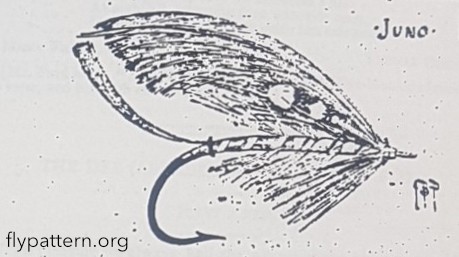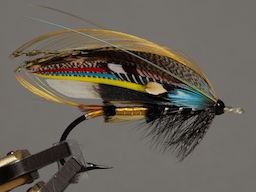From "The fishing gazette" - June 7th, 1884
FLY-MAKING is a subject which is frequently discussed amongst salmon anglers, though but little understood. There is no branch in the sport on which our ideas are so confused and so thoroughly opposed to each other's, unless it be in the selection by the river side of what we intend to use.
I have previously hinted that a little delicate deviation from the strict rules for correct blending is advantageous sometimes, but inexperienced amateurs should be cautious how they depart from pinciples which have been received generally, because founded on solid reasons; and how they relinquish customs which have been practically proved to be good.
It is a favourite dogma among modern writers on colour that "warm colours," perhaps reds and yellows, approach, or rather convey, nearness; and that blue, grey, and other retiring colours express distance. Such tenets most assuredly are absurd, for so far is this from being the case, that no expression of distance in the wide world is so great as that of the gold and orange which we often observe in the twilight sky. Colours, as such, are absolutely inexpressive respecting distance. It is their quality, their depth, or their delicacy which expresses distance - it cannot be their ting. It is quite true that, in certain objects, blue is a sign of distance, not because blue is a retiring colour, but because the mist in the air is blue, and, therefore, any warm colour which has not strength of light enough to pierce the mist is lost or subdued in its blue. When stones are seen through brown water, the deeper they may appear to lie the browner they look. There is, therefore, I think, one law about distance which has some claimes to be considered a constant one - namely, that dulness and heaviness of colour are more or less indicative of nearness.
Surely this reasoning is admissible; and, if so, why should it not be admitted that we are thus naturally led to mount dull, dark flies in coloured water, and bright or brilliant ones when the water is clear?
The working powers of our leading Ebglish gentlemen have been dwelt upon by very able pens, suggesting opinions complimentary enough, though directed probably only to political parties or even to the gentlemen in Throgmorton Street, with their three-fifths and a sixteenth multifarious calculations. Might not similar favourable opinions be expressed of the work in the art of artificial entomology?
Referring to Major Traherne's patterns, we all know that they are killers; each one is more or less different in character and appearance from our ordinary stock. Indeed, his familiarity with the subject has given hime competency, and in his power of invention, in his delicate manipulation, he has scarcely a single rival.
A peep at any of his cases and one would well wonder what birds there are to supply such beautiful feathers.
Though we may find quantities of birds that would provide fishermen with any envied colour, there are not so very many that are practically useful to us.
The Cock-of-the-rock, with its oily, ominous orange, splendid to look at, is one example; its feathers are far too limp to play properly in the water, and old fishermen never use them.
One of the best natural hackles, I believe, for very small flies can be obtained by holding that part of the blue chatterer which is purple close to the fire for a minute or so, which will make the otherwise useless feathers under the neck change at once and for ever to a good red tint, and although so small, they are very animate hackles in the water.
The scarlet Ibis, though most useful in the wing and tail of a fly, is abominable as hackle, and should never be employed for one. Neither should dyed blacks be used, but naturals, unless they are inteded for very large or coarse flies.
Except in my own collection I never see Toucan legs; there are no feathers that behave so well as these in the water, and although they are rather diminutive in fibre and length of stem, it is simple enough to wwind two together, and if that is insufficient, two more. No dye can produce a more perfect golden tinge, but they are only favoured when the water is very bright
Juno is also a fly for clear water, and another of Major Traherne's that may be entered in the list of "general flies."
Its description is as follows:-
Tag: Silver twist, and blue silk the same colour as the cheeks.
Tail: Topping.
Butt: Black herl.
Body: Orange silk half-way, the same shade as described in No. 1 illustration; and yellow silk the same tone as this hackle.
Hackle: Yellow macaw, from the yellow silk.
Ribbed: Silver lace, and silver tinsel.
Throat: Blue macaw.
Wings: Golden pheasant toppings.
Sides: Jungle fowl.
Cheeks: Kingfisher.
Horns: Blue macaw.
Head: Black herl.
And a magnificent fly this is. Where, indeed, is the fisherman who will not be struck with this lovely Juno! Shannon anglers need not be shy of her golden mane and tail, her natural petticoats of blue and yellow, her tag of floss, which combination would surely raise a dead up.
The harmony is simple superb, and it is here where scores of amateur dressers fail. I am not alluding to the every-day prodctions - the English or Welsh patterns, with merely claret bodies, turkey wings, a topping and a dollop of varnish at the head - but to real business, when, for instance, there are five or six dosen little feathers ordered for the body alone, which must taper as truly as one of Farlow's ferrules, and which, when completed, is to catch, instead of to scare, fish.
It will be seen in a week or two that I have under rather than over-rated these particulars. In my next illustration I shall be getting a trifle nearer to Major Traherne's more intricate and beautiful designs. ----
Thanks to Todd Kennedy - "Jock Scott", for providing a copy of the original article for this pattern.
|

